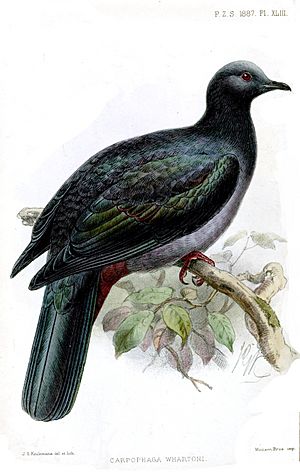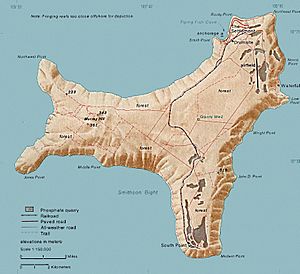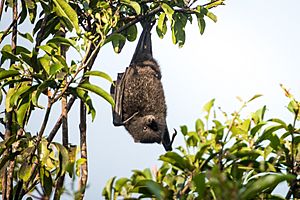Christmas imperial pigeon facts for kids
Quick facts for kids Christmas imperial pigeon |
|
|---|---|
 |
|
| 1887 illustration by Dutch bird illustrator John Gerrard Keulemans | |
| Conservation status | |
| Scientific classification | |
| Genus: |
Ducula
|
| Species: |
whartoni
|
| Synonyms | |
|
|
The Christmas imperial pigeon is a large bird. It is also called the Black imperial pigeon or Dusky imperial pigeon. Its scientific name is Ducula whartoni. This bird lives only on Christmas Island in the Indian Ocean.
It has a grey-blue color. Young birds are not as bright as adults. This pigeon makes a soft purring sound. It also makes a deep "whoo" sound, like a cow. It usually lays one shiny white egg.
The Christmas imperial pigeon eats only fruit. It is one of only two fruit-eating animals on the island. The other is the Christmas Island flying fox. These pigeons eat and nest high in the trees. They live mostly in the island's tropical forests. Scientists once thought this bird was in danger. This was due to losing its home and invasive species like the yellow crazy ant. But now, it is quite common. There are about 5,000 breeding birds.
Contents
About the Christmas Imperial Pigeon
What is the Christmas Imperial Pigeon?
The Christmas imperial pigeon is a type of imperial pigeon. These birds are found across Oceania. But the Christmas imperial pigeon is the only one in the Indian Ocean.
How Big Are These Pigeons?
Adult male pigeons are about 43.5 to 47 centimeters (17 to 18.5 inches) long. Females are about 44 to 46 centimeters (17.3 to 18.1 inches) long. Males weigh about 383 to 700 grams (0.8 to 1.5 pounds). Females weigh about 406 to 575 grams (0.9 to 1.2 pounds). They are large for pigeons but are quite light.
What Do They Look Like?
These pigeons are mostly grey-black. Their top feathers are darker. Their chest and belly feathers are lighter, with a reddish tint. They have a black beak. There is a small white band at the top of the beak. Their eyes can be yellow or orange.
The back of their neck and back feathers are shiny green. Their wing tips are shiny bluish-green. The rest of the wings are grey-brown. Their tail has wide, greenish-brown tips. Their legs and under-tail feathers are reddish-brown. Their feet are purple-red.
Young pigeons look like adults. But their colors are duller. They do not have the shiny green feathers. Their chest and belly are brown. Their head is dull grey. Their feet are grey-brown. Their eyes are dark brown.
What Sounds Do They Make?
The Christmas imperial pigeon makes a soft gurgling or purring sound. It can also make a deep "whoo" or "croo-croo-croo" sound. This sound is like a cow mooing far away. They sometimes clap their wings loudly. But they are mostly quiet when flying.
Life of the Christmas Imperial Pigeon
How Do They Find a Mate?
Male pigeons do a special dance to attract females. It is called a "perch coo." The male puffs up his chest a little. He presses his beak against his chest. He holds his wings close. Then he makes a loud "coo" sound. After that, he lowers his body almost flat. He repeats this movement many times.
Where Do They Build Nests?
These pigeons usually build their nests high up in the thick forest trees. One nest was about 20 centimeters (7.9 inches) wide. It was 6 centimeters (2.4 inches) thick. It was made only of dead twigs. This nest was about 8 meters (26 feet) off the ground.
When Do They Lay Eggs?
The main time for breeding is from November to April. But they can breed from August to April. They often lay one egg at a time. Sometimes they lay two. They might have two sets of babies each year.
One egg found in 1914 was white and shiny. It was about 4.1 centimeters (1.6 inches) long and 2.9 centimeters (1.1 inches) wide.
How Do Chicks Grow?
One chick was watched when it was about 10 to 13 days old. It was 20 centimeters (7.9 inches) long. Its feathers were starting to grow. By 22 days old, the chick looked like a small adult. But it still had some baby feathers. Its feet and eyes were brown. Its colors were duller.
The chick learned to fly when it was 24 to 27 days old. At this age, it was about 70% of its full size. It stayed with its parents for 17 more days. The parents fed the chick for 5 to 15 minutes at a time. The chick would poke its parent's throat. Then it would put its beak inside for about 12 seconds. It did this twice a minute. Feeding was seen in the morning. It probably happened again at night. The chick was left alone in the nest when not being fed.
Where Do They Live?

The Christmas imperial pigeon lives only on Christmas Island. This island is about 135 square kilometers (52 square miles) in size. It is in the eastern Indian Ocean. The pigeons mostly live in the green forests inland. But they can be found all over the island.
Some of their forest home was cut down for mining. But new trees, like the introduced Jamaican cherry tree, have grown back. These pigeons were also brought to the Coco Islands (probably Horsburgh Island) a long time ago. But they were last seen there in 1906.
What Do They Eat?
The Christmas imperial pigeon and the Christmas Island flying fox are the only main fruit-eating animals on the island. This means the pigeon helps spread seeds. They swallow seeds whole. Imperial pigeons can stretch their jaws to eat big fruits.
They eat fruits from plants like stinkwood, common fig, and chinaberry tree. The introduced Jamaican cherry tree is now a very important food source. Many pigeons are seen where this plant grows.
They usually eat in groups high in the trees. They also drink from springs or puddles. Sometimes they eat alone or in pairs. Even though they eat fruit, they have been seen eating leaves from the papaya plant. This might happen if there is not enough fruit.
The Christmas goshawk has been seen hunting young Christmas imperial pigeons.
Protecting the Christmas Imperial Pigeon
Are They in Danger?
The Christmas imperial pigeon is listed as "near threatened" by the International Union for Conservation of Nature (IUCN). This means they are not in immediate danger. Their population is stable. There are about 5,000 adult birds. They are considered common.
In the past, people thought their numbers were very low. In 1975, one expert thought there were only 20 to 200 birds. A survey in 2000 guessed there were 1,000 breeding birds. It was thought that the yellow crazy ant would cause a big drop in their numbers. But a 2003 survey found 35,000 to 66,000 birds. So, their numbers are good now.
What Threats Do They Face?
In the past, hunting was the main danger. It was easier to hunt them near roads where cherry trees grew. But hunting was made illegal in 1977.
Wild cats sometimes eat these pigeons. But it is more likely they eat pigeons that are already dead.
The yellow crazy ant might bother birds or their nests. These ants also cause problems for trees. This can harm the pigeon's home in the long run. The ants also reduce the number of Christmas Island red crabs. This changes the forest because the crabs usually eat young plants.
Scientists use bait with a chemical called Fipronil to control the ants. Studies showed fewer pigeons in areas where this bait was used. This might be due to seasons. But Fipronil can affect how birds eat and reproduce.
See also
 In Spanish: Dúcula de la Christmas para niños
In Spanish: Dúcula de la Christmas para niños



